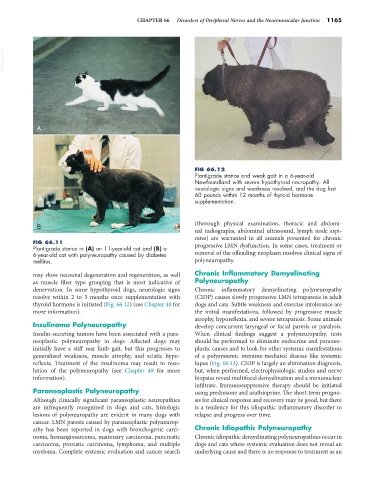Page 1193 - Small Animal Internal Medicine, 6th Edition
P. 1193
CHAPTER 66 Disorders of Peripheral Nerves and the Neuromuscular Junction 1165
VetBooks.ir
A
FIG 66.12
Plantigrade stance and weak gait in a 6-year-old
Newfoundland with severe hypothyroid neuropathy. All
neurologic signs and weakness resolved, and the dog lost
60 pounds within 12 months of thyroid hormone
supplementation.
(thorough physical examination, thoracic and abdomi-
B
nal radiographs, abdominal ultrasound, lymph node aspi-
rates) are warranted in all animals presented for chronic
FIG 66.11 progressive LMN dysfunction. In some cases, treatment or
Plantigrade stance in (A) an 11-year-old cat and (B) a
6-year-old cat with polyneuropathy caused by diabetes removal of the offending neoplasm resolves clinical signs of
mellitus. polyneuropathy.
may show neuronal degeneration and regeneration, as well Chronic Inflammatory Demyelinating
as muscle fiber type grouping that is most indicative of Polyneuropathy
denervation. In some hypothyroid dogs, neurologic signs Chronic inflammatory demyelinating polyneuropathy
resolve within 2 to 3 months once supplementation with (CIDP) causes slowly progressive LMN tetraparesis in adult
thyroid hormone is initiated (Fig. 66.12) (see Chapter 48 for dogs and cats. Subtle weakness and exercise intolerance are
more information). the initial manifestations, followed by progressive muscle
atrophy, hyporeflexia, and severe tetraparesis. Some animals
Insulinoma Polyneuropathy develop concurrent laryngeal or facial paresis or paralysis.
Insulin-secreting tumors have been associated with a para- When clinical findings suggest a polyneuropathy, tests
neoplastic polyneuropathy in dogs. Affected dogs may should be performed to eliminate endocrine and paraneo-
initially have a stiff rear limb gait, but this progresses to plastic causes and to look for other systemic manifestations
generalized weakness, muscle atrophy, and sciatic hypo- of a polysystemic immune-mediated disease like systemic
reflexia. Treatment of the insulinoma may result in reso- lupus (Fig. 66.13). CIDP is largely an elimination diagnosis,
lution of the polyneuropathy (see Chapter 49 for more but, when performed, electrophysiologic studies and nerve
information). biopsies reveal multifocal demyelination and a mononuclear
infiltrate. Immunosuppressive therapy should be initiated
Paraneoplastic Polyneuropathy using prednisone and azathioprine. The short-term progno-
Although clinically significant paraneoplastic neuropathies sis for clinical response and recovery may be good, but there
are infrequently recognized in dogs and cats, histologic is a tendency for this idiopathic inflammatory disorder to
lesions of polyneuropathy are evident in many dogs with relapse and progress over time.
cancer. LMN paresis caused by paraneoplastic polyneurop-
athy has been reported in dogs with bronchogenic carci- Chronic Idiopathic Polyneuropathy
noma, hemangiosarcoma, mammary carcinoma, pancreatic Chronic idiopathic demyelinating polyneuropathies occur in
carcinoma, prostatic carcinoma, lymphoma, and multiple dogs and cats where systemic evaluation does not reveal an
myeloma. Complete systemic evaluation and cancer search underlying cause and there is no response to treatment as an

